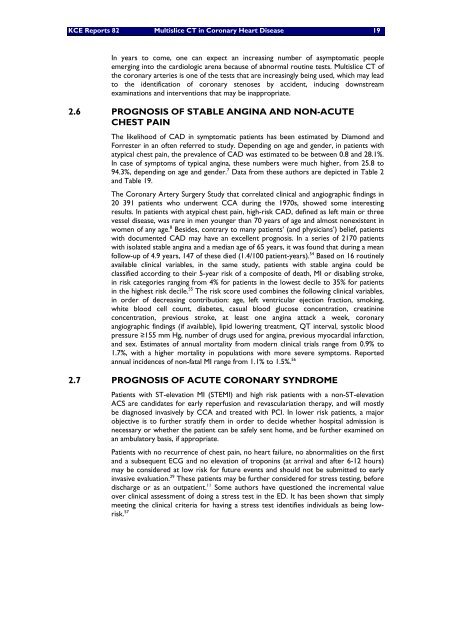Download the full report (116 p.) - KCE
Download the full report (116 p.) - KCE
Download the full report (116 p.) - KCE
Create successful ePaper yourself
Turn your PDF publications into a flip-book with our unique Google optimized e-Paper software.
<strong>KCE</strong> Reports 82 Multislice CT in Coronary Heart Disease 19<br />
In years to come, one can expect an increasing number of asymptomatic people<br />
emerging into <strong>the</strong> cardiologic arena because of abnormal routine tests. Multislice CT of<br />
<strong>the</strong> coronary arteries is one of <strong>the</strong> tests that are increasingly being used, which may lead<br />
to <strong>the</strong> identification of coronary stenoses by accident, inducing downstream<br />
examinations and interventions that may be inappropriate.<br />
2.6 PROGNOSIS OF STABLE ANGINA AND NON-ACUTE<br />
CHEST PAIN<br />
The likelihood of CAD in symptomatic patients has been estimated by Diamond and<br />
Forrester in an often referred to study. Depending on age and gender, in patients with<br />
atypical chest pain, <strong>the</strong> prevalence of CAD was estimated to be between 0.8 and 28.1%.<br />
In case of symptoms of typical angina, <strong>the</strong>se numbers were much higher, from 25.8 to<br />
94.3%, depending on age and gender. 7 Data from <strong>the</strong>se authors are depicted in Table 2<br />
and Table 19.<br />
The Coronary Artery Surgery Study that correlated clinical and angiographic findings in<br />
20 391 patients who underwent CCA during <strong>the</strong> 1970s, showed some interesting<br />
results. In patients with atypical chest pain, high-risk CAD, defined as left main or three<br />
vessel disease, was rare in men younger than 70 years of age and almost nonexistent in<br />
women of any age. 8 Besides, contrary to many patients’ (and physicians’) belief, patients<br />
with documented CAD may have an excellent prognosis. In a series of 2170 patients<br />
with isolated stable angina and a median age of 65 years, it was found that during a mean<br />
follow-up of 4.9 years, 147 of <strong>the</strong>se died (1.4/100 patient-years). 54 Based on 16 routinely<br />
available clinical variables, in <strong>the</strong> same study, patients with stable angina could be<br />
classified according to <strong>the</strong>ir 5-year risk of a composite of death, MI or disabling stroke,<br />
in risk categories ranging from 4% for patients in <strong>the</strong> lowest decile to 35% for patients<br />
in <strong>the</strong> highest risk decile. 55 The risk score used combines <strong>the</strong> following clinical variables,<br />
in order of decreasing contribution: age, left ventricular ejection fraction, smoking,<br />
white blood cell count, diabetes, casual blood glucose concentration, creatinine<br />
concentration, previous stroke, at least one angina attack a week, coronary<br />
angiographic findings (if available), lipid lowering treatment, QT interval, systolic blood<br />
pressure ≥155 mm Hg, number of drugs used for angina, previous myocardial infarction,<br />
and sex. Estimates of annual mortality from modern clinical trials range from 0.9% to<br />
1.7%, with a higher mortality in populations with more severe symptoms. Reported<br />
annual incidences of non-fatal MI range from 1.1% to 1.5%. 56<br />
2.7 PROGNOSIS OF ACUTE CORONARY SYNDROME<br />
Patients with ST-elevation MI (STEMI) and high risk patients with a non-ST-elevation<br />
ACS are candidates for early reperfusion and revasculariation <strong>the</strong>rapy, and will mostly<br />
be diagnosed invasively by CCA and treated with PCI. In lower risk patients, a major<br />
objective is to fur<strong>the</strong>r stratify <strong>the</strong>m in order to decide whe<strong>the</strong>r hospital admission is<br />
necessary or whe<strong>the</strong>r <strong>the</strong> patient can be safely sent home, and be fur<strong>the</strong>r examined on<br />
an ambulatory basis, if appropriate.<br />
Patients with no recurrence of chest pain, no heart failure, no abnormalities on <strong>the</strong> first<br />
and a subsequent ECG and no elevation of troponins (at arrival and after 6-12 hours)<br />
may be considered at low risk for future events and should not be submitted to early<br />
invasive evaluation. 29 These patients may be fur<strong>the</strong>r considered for stress testing, before<br />
discharge or as an outpatient. 11 Some authors have questioned <strong>the</strong> incremental value<br />
over clinical assessment of doing a stress test in <strong>the</strong> ED. It has been shown that simply<br />
meeting <strong>the</strong> clinical criteria for having a stress test identifies individuals as being lowrisk.<br />
57

















